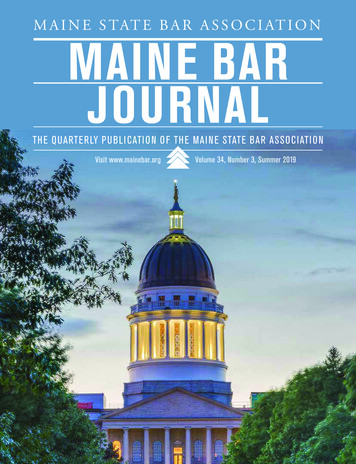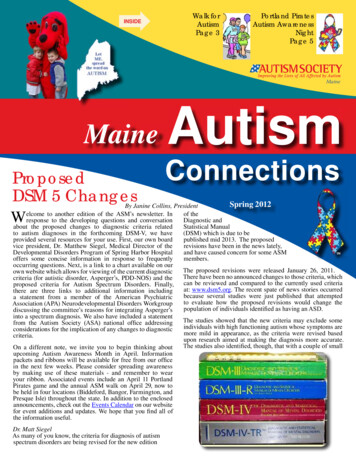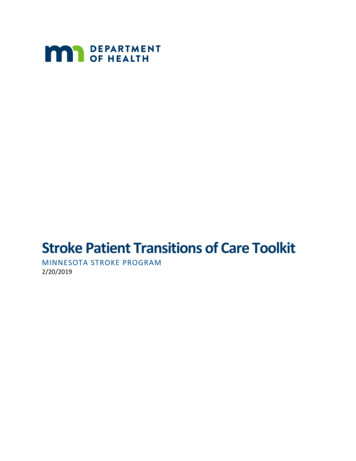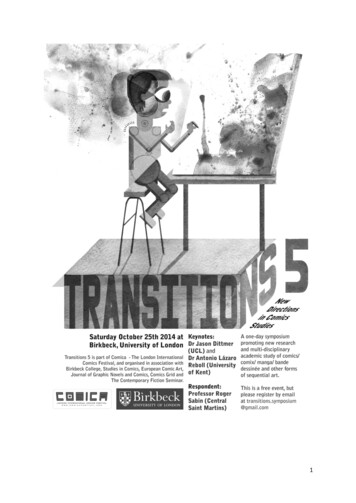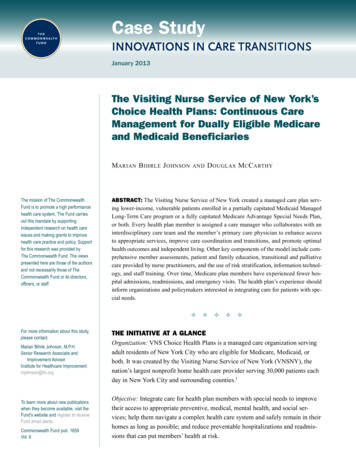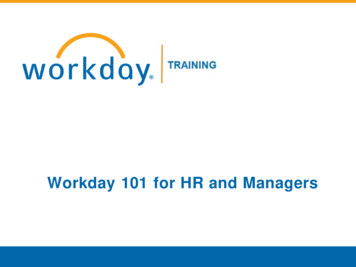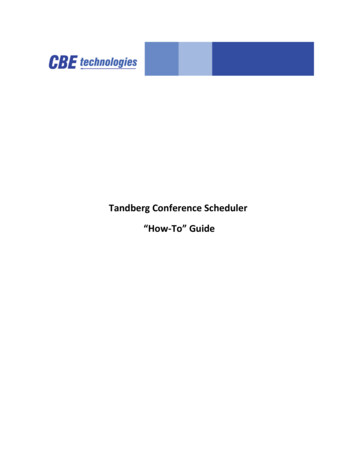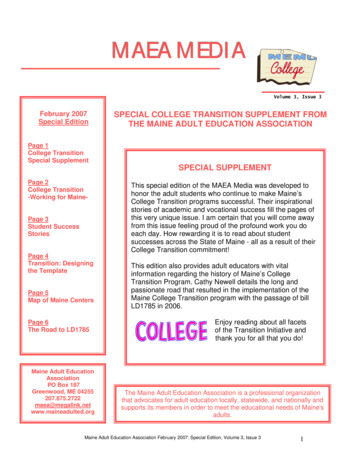
Transcription
MAEA MEDIAVolume 3, Issue 3February 2007Special EditionSPECIAL COLLEGE TRANSITION SUPPLEMENT FROMTHE MAINE ADULT EDUCATION ASSOCIATIONPage 1College TransitionSpecial SupplementSPECIAL SUPPLEMENTPage 2College Transition-Working for Maine-Page 3Student SuccessStoriesPage 4Transition: Designingthe TemplatePage 5Map of Maine CentersPage 6The Road to LD1785Maine Adult EducationAssociationPO Box 187Greenwood, ME .orgThis special edition of the MAEA Media was developed tohonor the adult students who continue to make Maine’sCollege Transition programs successful. Their inspirationalstories of academic and vocational success fill the pages ofthis very unique issue. I am certain that you will come awayfrom this issue feeling proud of the profound work you doeach day. How rewarding it is to read about studentsuccesses across the State of Maine - all as a result of theirCollege Transition commitment!This edition also provides adult educators with vitalinformation regarding the history of Maine’s CollegeTransition Program. Cathy Newell details the long andpassionate road that resulted in the implementation of theMaine College Transition program with the passage of billLD1785 in 2006.Enjoy reading about all facetsof the Transition Initiative andthank you for all that you do!The Maine Adult Education Association is a professional organizationthat advocates for adult education locally, statewide, and nationally andsupports its members in order to meet the educational needs of Maine'sadults.Maine Adult Education Association February 2007: Special Edition, Volume 3, Issue 31
COLLEGE TRANSITION-Working for MaineJudy Ruszczk enrolled in the Rockland College Transition program in fall of 2004 after 25years out of school. She wanted to return to the nursing profession but had no idea how to evengather her transcripts to begin the application process. In addition, she had low self-esteem andneeded a support network in order to help her overcome her self doubt. Judy enrolled in ourprogram and was a very dedicated and strong student. She was a peer leader and an incredibleinspiration to other students.Judy had been a Licensed Practical Nurse (LPN) for over 20 years. But aftersuffering intense personal and family tragedies, Judy began to drink. After losingher job, the most beloved part of her life, she moved to Maine and embarked on asobering journey. Sober for nine months, Judy enrolled in College Transition toultimately fulfill her goal to become a Registered Nurse. Upon successfulcompletion of the Transition program, Judy spent the following spring and summersemesters working to complete her Nursing Program pre-requisites. She took Anatomy &Physiology, Public Speaking, Chemistry, Algebra, Micro Biology and an LPN to RNTransitions course - all in the span of two semesters! Judy was fast-tracked into the2nd year of the Nursing Program due to her intense commitment to the program and because ofher former work as an LPN. She earned a 3.4 GPA and graduated from the school of nursing.She is now employed as an RN in Maine.Patty Provost of Sumner College Transition Project, Summer 2003Patty was 38-years-old and a single parent because her husband was in federal prison out ofstate. She attended the Transitions Project during the summer of 2003. For the first five or sixweeks of class, Patty was convinced that college could never happen for her andshe was shocked to be accepted, stunned to receive adequate financial aid, andinspired after talking with her prospective advisor. Starting her AS in CriminalJustice at University College at Bangor (UCB) that fall, Patty is now earningher BS, with consistently strong grades. She started a legal research businesswith a professor and, developed a lending library program at the Penobscot County Jail. Herfamily is back together and Patty continues to actively contribute to her family, her school, andher community. Patty is quite the inspiration and has a bright future!How My Life Has Changed because of the College Transition Program:I no longer have to work two minimum wage jobs.I now have the ability to choose the work I wish to pursue.I no longer receive food stamps.I can purchase my own food without help from the state, local or federal government.Because of this I can shop without the stigma of people thinking I’m a lazy, no good bum.I no longer receive fuel assistance. I choose and purchase my own energy source.I no longer have to hide disconnection notices from my children because I am able to pay mybills on time.My children see a mother who works hard and comes home at the end of the day happy insteadof a mother who works hard and comes home at the end of the day worried, frustrated andcrying all the time.Submitted by Ronda Alley, College Transitions student & college graduateMaine Adult Education Association February 2007: Special Edition, Volume 3, Issue 32
SHARED STORIES of SUCCESSCollege Transition Students throughout Maine Tina, a 42-year-old single parent, had just left an abusive relationshipwhen she started our Transition Project in the spring of 2002. She worked as a privatehousekeeper, cleaning several homes to support herself and her school-aged daughter.Shy, yet determined, Tina completed the Project and started University ofMaine in Augusta part-time that fall. Tina is now a full time Ed Tech for herlocal school with benefits and a full sense of pride in her accomplishments! Lynn, 35, completed the Transitions Project in the Summer of 2000.Overcoming early academic challenges, Lynn developed a kind of savvy thatallowed her to progress onto the eligibility list for a restricted AS/BS at UC-Bangor. Lynnhad to stop-out for a year to wait for her degree slot, but graduated in 2005. Lynn is nowa Dental Hygienist in the Ellsworth area. Yvonne, 47, a single mother and laborer joined the College Transition program inRockland and gained up enough confidence to take the ParaPro assessment and pursueher dream of becoming an educator. She passed the test and worked as a special andregular education substitute in the mid-coast. She will start college in the fall of 2007along with her full-time EdTech position. Johnny, a 32-year-old Navy veteran, had been working at the Winter Harbor NavyBase, when it closed and he became a dislocated worker. Johnny received release timein the spring of 2002 to attend the Transition Project, and then started at Eastern MaineCommunity College. Johnny completed his A.A. in Liberal Studies and transferred it intoUniversity of Maine Augusta’s B.A. in Social Sciences with a psychology focus atUniversity College-Bangor. Johnny graduated with his B.A. in 2006. Angela, 31, a young mom and wife from Harrington, completed the TransitionProject during the summer of 2001. Determined to become a nurse after her bestfriend died of breast cancer, Angela started at UMaine Machias in the fall of 2001 inLiberal Arts with a focus on pre-nursing. She also worked on the Beth C. Wright, CancerResource Center project in Ellsworth and as a CNA at a local nursing home. Angelagraduated in May 2005 and is a practicing Registered Nurse in Washington County. Cheryl, 42 and newly divorced, needed to make a living to support her evergrowing family. The State of Maine permanently placed her twin infant grandchildren inher care due to drug-abuse issues of an older son. She did not allow these additionalphysical or emotional demands to keep her from continuing with her degree. Needing torelocate her family to Florida to escape on-going abuse issues, Cheryl is currentlypursuing her degree to become an Elementary Teacher at Central Florida University.Maine Adult Education Association February 2007: Special Edition, Volume 3, Issue 33
The Transition Program – A Template OverviewThe Transition Program Template is a set of recommendations based on national collegetransitions experiences and the input of all seven currently operating Maine ABE-to-Collegeprograms funded by New England Literacy Resource Center Nellie Mae Grants.1. What makes a good College Transitions program?Program Identity: A significant factor in program success and continuation is an identifiableprogram name or service in the community that sets it apart from the regular adult educationofferings. This could take the form of a location for services, a separate flyer or specificadvertising and/or specific staff identified as working with transitions.2. What should be the first priority of any College Transition Program?Accurate Identification of Student Needs:This statement encompasses academics, building (student) relationships, identifying strengthsand weakness of students, career goal setting, rigorous academics and developing personalresponsibility and should be viewed as an overriding priority for the application of any counselingor academic program to follow. Individual portfolios and accurate tracking and record keepingare essential elements.3. What best practice needs to be promoted and implemented in any new CollegeTransitions program?A “defined process” needs to include elements of program design to include:a) A formal process for intake, orientation and graduationb) Accuplacer testing on sitec) A formal process for portfolio developmentd) A defined data collection process, include documentationof assessment and follow upe) A staff development component for teachers and counselorsIn summary, the best practice would be a defined, replicable design that could beimplemented at local programs in varying levels of intensity dependent on regional needs.4 Based on your experience, what advice would you give to someone starting aCollege Transitions program?Individual Program Staff Responses:f) Spend time on planningg) Review existing research on Transitionsh) Visit existing projectsi) View Transitions as part of a continuumj) Build linkages with collegesk) Establish a local identityl) Be flexible, be patientm) Celebrate successThis Template is the summary result of a Meeting of the Nellie Mae Maine ABE-to-College Transition Programs, Lewiston,Maine, January 26, 2006. In Attendance: Roger Dyer, Gloria Berube, Ann Marie Villote, Rob Wood, Connie Patton, SallyDaniels, Darrell Gilman, Shannon Parker, Deepa Rao and Patrick O’Regan.Maine Adult Education Association February 2007: Special Edition, Volume 3, Issue 34
MAP OF MAINE ADULT EDUCATION CENTERSHIGHLIGHTING GRANTS FROMMaine CollegeTransition Pilot sitesMaine College Transition (7)
The Road to LD 17851989 – Advent of University of Maine’s ITV system with high school sites often managed byadult education in local high schools. Use of Perkins funds for a small number of courses andcollege counseling on a limited scale.1990’s – Attempts at collaborative agreement with University of Maine System and adulteducation. This was never completed due to personnel changes1999 – “Outreach Proposal” by King administration. Never really developedinto a bill, but would have funded a few programs.2001 – Nellie Mae Foundation came on scene with ABE-to-College Grants,eventually expanding to seven sites with the goal of developing a model overfive years with 40,000 per program per year.2002 – Collaborative Agreement signed with Maine Community College System and MaineAdult Education Association. Similar agreement with UMS was in development but, again,personnel changes prevented completion.2002 and 2004 – The Betterment Fund provided small grants to fund a conference in bothyears to educate adult education programs and post-secondary partners on College Transitions.2003 – Maine Compact for Higher Education identified Adult Education College Transition asone of five key strategies to increase the number of adults with college degrees in Maine. Thegoal of 40,000 new degrees cannot be reached without adults.2005 – Lumina Foundation provided funding for leadership in moving to a state-wide program.Curriculum development, assessment of program readiness, coordination with communitycolleges, and MOU’s between CC campuses and adult education programs.2005 – Governor’s PreK-16 Committee identifies adult education as a key link.2005 – MELMAC Education Foundation added adult education to their grant program. 24programs are involved with exploring specific aspects of the MELMAC model with relation toadults. 4,000 per program per year for 2 years.2006 – Senator Libby Mitchell identified Adult Education College Transition as a criticalstrategy for education and economic development in light of plant closings and the changingnature of the Maine economy and agreed to sponsor it. Legislative Council accepted the bill forthe 2005 session.2006 – The Education Committee voted Unanimous Ought to Pass for LD 1785and 200,000 was appropriated for the initial six sites, with funding for a 7th securedfrom the Betterment Fund, and a grant from the Nellie Mae Foundation for programleadership.2007 – Maine College Transition was begun with strong legislative support witha 200,000 appropriation and the passage of LD 1785 outlining the plan to expandthe program in the future.2007 – In his budget, Governor Baldacci moves to accelerate the Maine College Transitionprogram to full implementation of 30 sites. Pilot sites substantially exceed enrollmentprojections for the first semester.Maine Adult Education Association February 2007: Special Edition, Volume 3, Issue 36
Judy had been a Licensed Practical Nurse (LPN) for over 20 years. But after suffering intense personal and family tragedies, Judy began to drink. After losing . Patty Provost of Sumner College Transition Project, Summer 2003 Patty was 38-y
